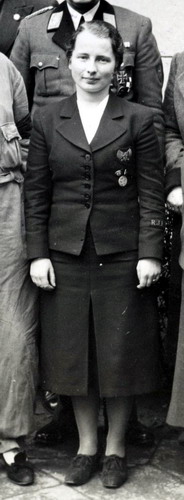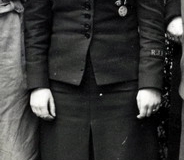 Shortly after Dr. Jutta Ruediger took over as the National Speaker of the League of German Girls in 1937, regional and local leaders of the League received new rank insignia as well as new uniforms.
Shortly after Dr. Jutta Ruediger took over as the National Speaker of the League of German Girls in 1937, regional and local leaders of the League received new rank insignia as well as new uniforms.
Several different uniforms were designed by Berlin fashion houses, and the BDM’s leadership staff eventually decided on the design by fashion house Schulze-Bibernell, which consisted of a smart dark blue costume worn with a white blouse as seen in the photo on the right.
The new uniforms started to see service between 1938 and 1940, and were dark blue. The everyday Dienstkleidung, service clothing, comprised a single-breasted dark blue tunic with six black or blue plastic (usually bakelite) buttons down the front and three on each cuff. It was worn with a white blouse, a dark blue skirt, brown or grey stockings, and blue or black leather lace-up shoes. Unlike with the other uniforms of the League of German Girls, leaders now no longer wore the neckerchief of knot slide, and they also no longer wore the leadership lanyards or Gaudreieck insignia.
The leadership lanyards had been replaced with new insignia that were embroidered in either silver, or for higher ranks, gold bullion, onto a black shield, with various styles of surrounds indicating the rank. This new insignia was worn on the left chest of all the new leader uniforms, including the rain cape and the overcoat.
The Gaudreieck insignia, too, was not used on leader uniforms. Leaders instead wore a cufftitle that was black with silver bullion embroidery of their region’s name. Members of the national leadership staff in Berlin wore a cufftitle with the letters RJF embroidered on it, which stood for “Reichsjugendfuehrung”.
Formal dress, or Festkleidung, took the form of a closed-neck tunic with concealed buttons, two side pockets, and a short Mandarin-style collar. Aside from the formal tunic, the rest of the ensemble remained the same.
To replace the brown greatcoat that used to be worn by leaders previously, and which had never been very popular, a new dark blue winter coat was introduced, which featured a broad collar that could also be worn as a hood. A sleeved rain cape that was secured with an ornamental chain at the neck, could be worn as an alternative to the overcoat and was prescribed to be worn with the formal uniform.
For summer, a lightweight white cotton tunic was introduced in June of 1939, and can be seen making its debut during a visit of BDM leaders to Spain.
Uniform References
To be of additional help to researchers, here are a listing of the leader insignia and some images of the uniforms. You may find additional photos of leaders in those new uniforms in the BDM photographs section.
Copyright of these two pages belongs to David Littlejohn. They are from his book “The Hitler Youth”, published by Agincourt Publishers.





